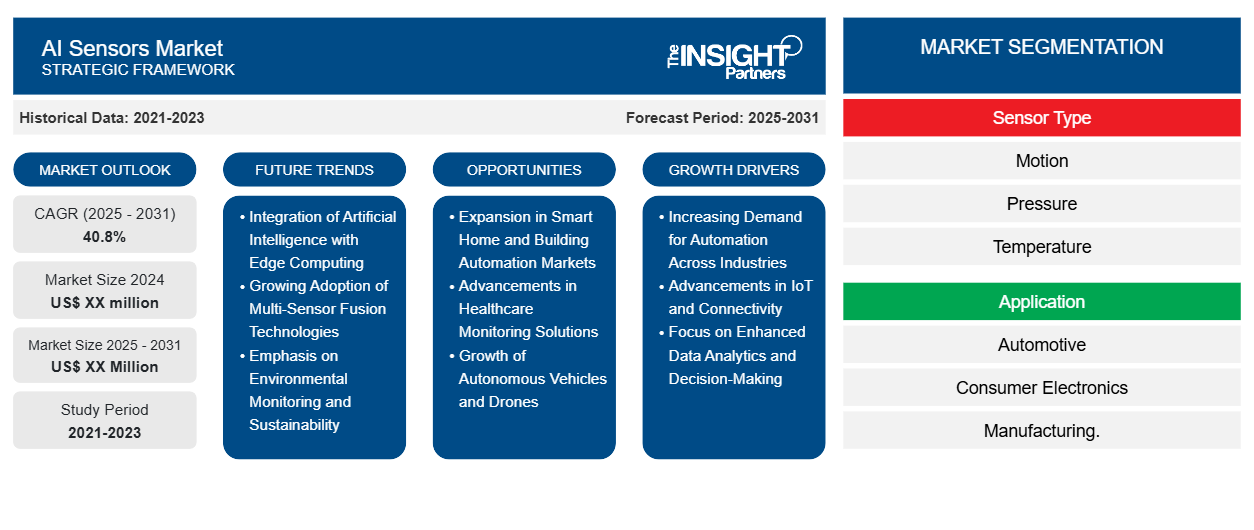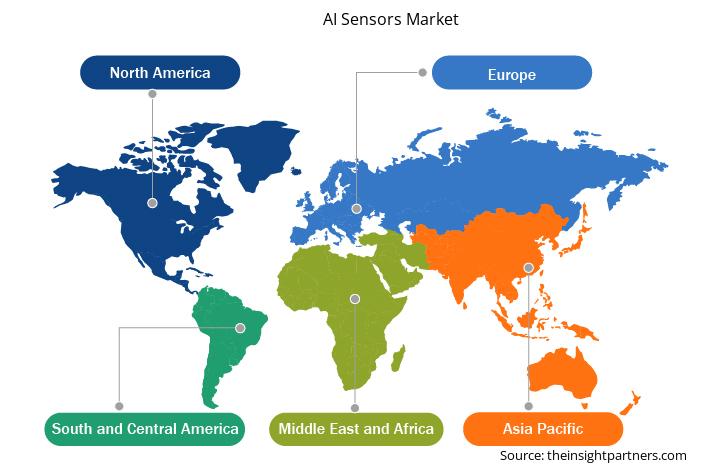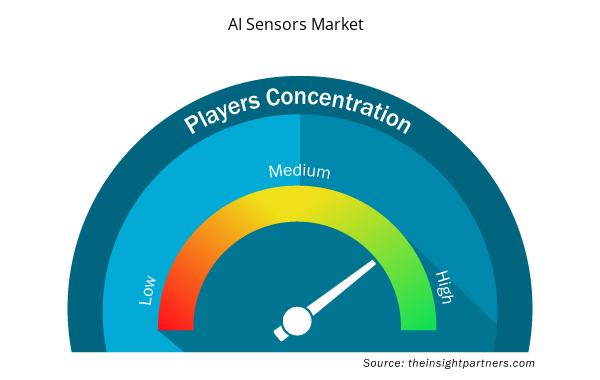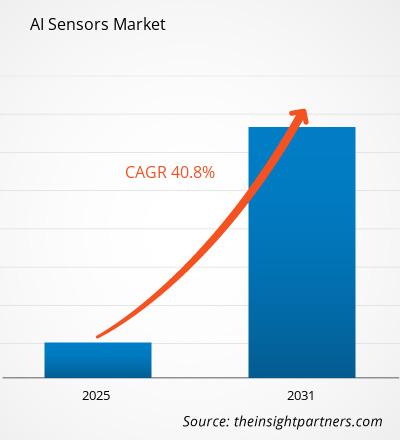من المتوقع أن يسجل سوق أجهزة استشعار الذكاء الاصطناعي معدل نمو سنوي مركب بنسبة 40.8٪ من عام 2025 إلى عام 2031، مع توسع حجم السوق من XX مليون دولار أمريكي في عام 2024 إلى XX مليون دولار أمريكي بحلول عام 2031.
يتم تقسيم التقرير حسب نوع المستشعر (الحركة، الضغط، درجة الحرارة، البصري، الموضع)، والتطبيق (السيارات، الإلكترونيات الاستهلاكية، التصنيع).
غرض التقرير
يهدف تقرير "سوق مستشعرات الذكاء الاصطناعي" الصادر عن شركة "ذا إنسايت بارتنرز" إلى وصف المشهد الحالي والنمو المستقبلي، وأهم العوامل المحفزة، والتحديات، والفرص المتاحة. وسيوفر هذا التقرير رؤى ثاقبة لمختلف أصحاب المصلحة في قطاع الأعمال، مثل:
- مزودي التكنولوجيا/المصنعين: لفهم ديناميكيات السوق المتطورة ومعرفة فرص النمو المحتملة، وتمكينهم من اتخاذ قرارات استراتيجية مستنيرة.
- المستثمرون: إجراء تحليل شامل للاتجاهات فيما يتعلق بمعدل نمو السوق، والتوقعات المالية للسوق، والفرص المتاحة عبر سلسلة القيمة.
- الهيئات التنظيمية: لتنظيم السياسات ومراقبة الأنشطة في السوق بهدف تقليل الانتهاكات والحفاظ على ثقة المستثمرين ودعم سلامة السوق واستقرارها.
تجزئة سوق أجهزة استشعار الذكاء الاصطناعي
نوع المستشعر
- حركة
- ضغط
- درجة حرارة
- بصري
- موضع
طلب
- السيارات
- الالكترونيات الاستهلاكية
- تصنيع.
قم بتخصيص هذا التقرير ليناسب متطلباتك
ستحصل على تخصيص لأي تقرير - مجانًا - بما في ذلك أجزاء من هذا التقرير، أو تحليل على مستوى الدولة، وحزمة بيانات Excel، بالإضافة إلى الاستفادة من العروض والخصومات الرائعة للشركات الناشئة والجامعات
سوق أجهزة استشعار الذكاء الاصطناعي: رؤى استراتيجية

- احصل على أهم اتجاهات السوق الرئيسية لهذا التقرير.ستتضمن هذه العينة المجانية تحليل البيانات، بدءًا من اتجاهات السوق وحتى التقديرات والتوقعات.
عوامل نمو سوق أجهزة استشعار الذكاء الاصطناعي
- تزايد الطلب على الأتمتة في مختلف القطاعات: يُعد التوجه نحو الأتمتة في مختلف القطاعات، بما في ذلك التصنيع والرعاية الصحية والسيارات والزراعة، محركًا رئيسيًا لسوق مستشعرات الذكاء الاصطناعي. وفي ظل سعي القطاعات إلى تعزيز الكفاءة التشغيلية وتقليل الأخطاء البشرية وتحسين العمليات، تلعب مستشعرات الذكاء الاصطناعي دورًا محوريًا من خلال توفير بيانات ورؤى آنية. وتستفيد هذه المستشعرات من خوارزميات التعلم الآلي لتحليل أنماط البيانات، مما يُمكّن من الصيانة التنبؤية ومراقبة الجودة وتحسين عملية اتخاذ القرارات. ويدفع التركيز المتزايد على الأتمتة عجلة تبني مستشعرات الذكاء الاصطناعي، مما يؤدي إلى نمو كبير في السوق.
- التطورات في إنترنت الأشياء والاتصال: يُسهم التطور السريع لإنترنت الأشياء (IoT) بشكل كبير في نمو سوق مستشعرات الذكاء الاصطناعي. ومع انتشار الأجهزة المتصلة، تزداد الحاجة إلى مستشعرات قادرة على جمع البيانات ونقلها وتحليلها عبر تطبيقات متنوعة. وتتكامل مستشعرات الذكاء الاصطناعي المجهزة بإمكانيات اتصال متقدمة بسلاسة مع أنظمة إنترنت الأشياء، مما يُتيح معالجة البيانات بذكاء وتحليلها آنيًا. ويُعزز هذا التكامل وظائف الأجهزة والأنظمة الذكية، مما يزيد الطلب على مستشعرات الذكاء الاصطناعي في المنازل الذكية والمدن الذكية وتطبيقات إنترنت الأشياء الصناعية.
- التركيز على تحسين تحليلات البيانات واتخاذ القرارات: تُعدّ الأهمية المتزايدة لاتخاذ القرارات القائمة على البيانات محركًا رئيسيًا لسوق أجهزة استشعار الذكاء الاصطناعي. وتدرك المؤسسات بشكل متزايد أهمية تحليلات البيانات في اكتساب رؤى ثاقبة حول الأداء التشغيلي وسلوك المستهلك. وتُسهم أجهزة استشعار الذكاء الاصطناعي في هذا التوجه من خلال جمع كميات هائلة من البيانات من بيئاتها وتطبيق تحليلات متقدمة لاستخلاص رؤى عملية. ولا يقتصر دور هذه الإمكانية على تحسين الكفاءة التشغيلية فحسب، بل تدعم أيضًا الابتكار والتخطيط الاستراتيجي، مما يُعزز الطلب على تقنيات استشعار الذكاء الاصطناعي في مختلف القطاعات.
اتجاهات مستقبل سوق أجهزة استشعار الذكاء الاصطناعي
- دمج الذكاء الاصطناعي مع الحوسبة الطرفية: يُعد دمج تقنيات الذكاء الاصطناعي مع الحوسبة الطرفية من أبرز التوجهات في سوق مستشعرات الذكاء الاصطناعي. يتيح هذا النهج معالجة البيانات بالقرب من مصدر توليدها، مما يُقلل زمن الوصول ويُعزز قدرات اتخاذ القرارات الفورية. ومن خلال دمج خوارزميات الذكاء الاصطناعي مباشرةً في المستشعرات، يُمكن للمؤسسات تحقيق أوقات استجابة أسرع وكفاءة مُحسّنة في تطبيقات مثل الأتمتة الصناعية والمركبات ذاتية القيادة والبنية التحتية للمدن الذكية. ويُبرز هذا التوجه الحاجة المتزايدة إلى أنظمة ذكية قادرة على العمل بشكل مستقل والاستجابة للظروف المتغيرة في الوقت الفعلي.
- تزايد اعتماد تقنيات دمج أجهزة الاستشعار المتعددة: يكتسب التوجه نحو دمج أجهزة الاستشعار المتعددة زخمًا متزايدًا في سوق مستشعرات الذكاء الاصطناعي، حيث تُدمج البيانات من أجهزة استشعار متعددة لتوفير فهم أشمل للبيئة. ومن خلال دمج البيانات من أنواع مختلفة من أجهزة الاستشعار (مثل: البصرية، والحرارية، والصوتية)، يمكن للمؤسسات تعزيز دقة وموثوقية أنظمتها. ويُعد هذا النهج ذا قيمة خاصة في تطبيقات مثل القيادة الذاتية، والروبوتات، والمراقبة، حيث تُعد الرؤية الشاملة للمحيط أمرًا أساسيًا لاتخاذ قرارات فعالة. ويدفع الطلب المتزايد على قدرات الاستشعار المتقدمة إلى اعتماد تقنيات دمج أجهزة الاستشعار المتعددة.
- التركيز على الرصد البيئي والاستدامة: يُعدّ التركيز المتزايد على الرصد البيئي والاستدامة اتجاهًا هامًا يؤثر على سوق أجهزة استشعار الذكاء الاصطناعي. مع تزايد المخاوف بشأن تغير المناخ والتلوث، تزداد الحاجة إلى أجهزة استشعار قادرة على رصد المؤشرات البيئية، مثل جودة الهواء وجودة المياه وانبعاثات غازات الاحتباس الحراري. تُوفّر أجهزة استشعار الذكاء الاصطناعي المُزوّدة بتحليلات متقدمة رؤى آنية حول الظروف البيئية، مما يُمكّن المؤسسات والحكومات من اتخاذ قرارات مدروسة بشأن مبادرات الاستدامة. يعكس هذا التوجه التوافق المتزايد بين التكنولوجيا والمسؤولية البيئية، مما يُحفّز الابتكار في تطبيقات أجهزة استشعار الذكاء الاصطناعي.
فرص سوق أجهزة استشعار الذكاء الاصطناعي
- التوسع في أسواق المنازل الذكية وأتمتة المباني: يُتيح الاهتمام المتزايد بالمنازل الذكية وأتمتة المباني فرصًا كبيرة لسوق مستشعرات الذكاء الاصطناعي. فمع سعي المستهلكين لتحسين الراحة والأمان وكفاءة الطاقة، يُمكن لمستشعرات الذكاء الاصطناعي أن تلعب دورًا محوريًا في أتمتة بيئات المنازل وتحسينها. بدءًا من منظمات الحرارة الذكية وأنظمة الأمان وصولًا إلى حلول إدارة الطاقة، يتزايد الطلب على المستشعرات الذكية القادرة على مراقبة مختلف جوانب عمليات المنازل والمباني والتحكم فيها. ويمكن للشركات التي تُطوّر حلول مستشعرات ذكاء اصطناعي مبتكرة مُصممة خصيصًا لتطبيقات المنازل الذكية الاستفادة من هذه السوق الناشئة.
- التطورات في حلول مراقبة الرعاية الصحية: يوفر قطاع الرعاية الصحية فرصًا كبيرة لسوق أجهزة استشعار الذكاء الاصطناعي، لا سيما في مجال مراقبة المرضى عن بُعد وتشخيص الحالات الصحية. توفر أجهزة استشعار الذكاء الاصطناعي بيانات آنية حول العلامات الحيوية ومستويات النشاط والظروف البيئية، مما يُمكّن مقدمي الرعاية الصحية من مراقبة المرضى بفعالية خارج نطاق البيئات السريرية التقليدية. يُعزز الاعتماد المتزايد على تقنيات الرعاية الصحية عن بُعد والأجهزة القابلة للارتداء الطلب على أجهزة استشعار متطورة قادرة على جمع البيانات الصحية وتحليلها. وستستفيد الشركات التي تُركز على تطوير أجهزة استشعار الذكاء الاصطناعي لتطبيقات الرعاية الصحية من هذا التوجه المتنامي.
- نمو المركبات ذاتية القيادة والطائرات بدون طيار: يُمثل صعود المركبات ذاتية القيادة والطائرات بدون طيار فرصةً واعدةً لسوق أجهزة استشعار الذكاء الاصطناعي. تعتمد هذه التقنيات بشكلٍ كبير على قدرات استشعار متقدمة للتنقل والعمل بأمان في بيئات مُختلفة. تلعب أجهزة استشعار الذكاء الاصطناعي، بما في ذلك الليدار والكاميرات والرادار، دورًا حاسمًا في تمكين الإدراك واتخاذ القرارات في الأنظمة ذاتية القيادة. ومع استمرار ابتكار وتوسع صناعتي السيارات والطائرات بدون طيار، سيزداد الطلب على تقنيات استشعار الذكاء الاصطناعي المُتطورة، مما يُتيح فرصًا مُربحة للمُصنّعين والمُطورين في هذا المجال.
رؤى إقليمية حول سوق أجهزة استشعار الذكاء الاصطناعي
قام محللو إنسايت بارتنرز بشرح شامل للاتجاهات الإقليمية والعوامل المؤثرة في سوق مستشعرات الذكاء الاصطناعي خلال فترة التوقعات. ويناقش هذا القسم أيضًا قطاعات سوق مستشعرات الذكاء الاصطناعي ونطاقها الجغرافي في أمريكا الشمالية، وأوروبا، وآسيا والمحيط الهادئ، والشرق الأوسط وأفريقيا، وأمريكا الجنوبية والوسطى.

- احصل على البيانات الإقليمية المحددة لسوق أجهزة استشعار الذكاء الاصطناعي
نطاق تقرير سوق أجهزة استشعار الذكاء الاصطناعي
| سمة التقرير | تفاصيل |
|---|---|
| حجم السوق في عام 2024 | XX مليون دولار أمريكي |
| حجم السوق بحلول عام 2031 | XX مليون دولار أمريكي |
| معدل النمو السنوي المركب العالمي (2025 - 2031) | 40.8% |
| البيانات التاريخية | 2021-2023 |
| فترة التنبؤ | 2025-2031 |
| القطاعات المغطاة | حسب نوع المستشعر
|
| المناطق والدول المغطاة | أمريكا الشمالية
|
| قادة السوق وملفات تعريف الشركات الرئيسية |
|
كثافة اللاعبين في سوق أجهزة استشعار الذكاء الاصطناعي: فهم تأثيرها على ديناميكيات الأعمال
يشهد سوق مستشعرات الذكاء الاصطناعي نموًا سريعًا، مدفوعًا بتزايد طلب المستخدمين النهائيين نتيجةً لعوامل مثل تطور تفضيلات المستهلكين، والتقدم التكنولوجي، وزيادة الوعي بمزايا المنتج. ومع تزايد الطلب، تعمل الشركات على توسيع عروضها، والابتكار لتلبية احتياجات المستهلكين، والاستفادة من الاتجاهات الناشئة، مما يُعزز نمو السوق.
تشير كثافة اللاعبين في السوق إلى توزيع الشركات العاملة في سوق أو قطاع معين. وتشير إلى عدد المنافسين (اللاعبين في السوق) الموجودين في سوق معين نسبةً إلى حجمه أو قيمته السوقية الإجمالية.
الشركات الرئيسية العاملة في سوق أجهزة استشعار الذكاء الاصطناعي هي:
- ACI العالمية
- شركة بايدو
- بي أيه إي سيستمز، ليكسيس نيكسيس لحلول المخاطر
- شركة أوراكل
- شركة تيليداين تكنولوجيز
- شركة روبرت بوش المحدودة
إخلاء المسؤولية : الشركات المذكورة أعلاه ليست مرتبة بأي ترتيب معين.

- احصل على نظرة عامة على أهم اللاعبين الرئيسيين في سوق أجهزة استشعار الذكاء الاصطناعي
نقاط البيع الرئيسية
- التغطية الشاملة: يغطي التقرير بشكل شامل تحليل المنتجات والخدمات والأنواع والمستخدمين النهائيين لسوق أجهزة استشعار الذكاء الاصطناعي، مما يوفر مشهدًا شاملاً.
- تحليل الخبراء: تم تجميع التقرير على أساس الفهم العميق لخبراء الصناعة والمحللين.
- معلومات محدثة: يضمن التقرير أهمية الأعمال التجارية بسبب تغطيته للمعلومات الحديثة واتجاهات البيانات.
- خيارات التخصيص: يمكن تخصيص هذا التقرير لتلبية متطلبات العملاء المحددة وتلبية استراتيجيات العمل بشكل مناسب.
لذا، يُمكن أن يُساعد تقرير البحث حول سوق مستشعرات الذكاء الاصطناعي في تمهيد الطريق لفهم سيناريوهات الصناعة وآفاق نموها. ورغم وجود بعض المخاوف المُبررة، إلا أن فوائد هذا التقرير الإجمالية تفوق عيوبه.
- التحليل التاريخي (سنتان)، السنة الأساسية، التوقعات (7 سنوات) مع معدل النمو السنوي المركب
- تحليل PEST و SWOT
- حجم السوق والقيمة / الحجم - عالميًا وإقليميًا وقطريًا
- الصناعة والمنافسة
- مجموعة بيانات Excel



Report Coverage
Revenue forecast, Company Analysis, Industry landscape, Growth factors, and Trends

Segment Covered
This text is related
to segments covered.

Regional Scope
North America, Europe, Asia Pacific, Middle East & Africa, South & Central America

Country Scope
This text is related
to country scope.
الأسئلة الشائعة
The report can be delivered in PDF/PPT format; we can also share excel dataset based on the request.
ACI Worldwide#Baidu, Inc.#BAE Systems, LexisNexis Risk Solutions, Oracle Corporation, Teledyne Technologies Incorporated, Robert Bosch GmbH, Sensata Technologies, Inc., Sensirion AG, Goertek, Hokuriku Electric, MEMSIC Semiconductor, Movella, Silicon Sensing Systems Limited, Sony Corporation, SAS Institute
A prominent trend in the AI sensors market is the integration of AI technologies with edge computing. This approach allows data processing to occur closer to the source of data generation, reducing latency and enhancing real-time decision-making capabilities.
The drive towards automation in various sectors, including manufacturing, healthcare, automotive, and agriculture, is a major driver for the AI sensors market. As industries seek to enhance operational efficiency, reduce human error, and optimize processes, AI sensors play a crucial role by providing real-time data and insights. These sensors leverage machine learning algorithms to analyze data patterns, enabling predictive maintenance, quality control, and improved decision-making. The growing emphasis on automation is propelling the adoption of AI sensors, leading to significant market growth.
The global AI Sensors market is expected to grow at a CAGR of 40.8% during the forecast period 2024 - 2031.
Trends and growth analysis reports related to Electronics and Semiconductor : READ MORE..
The Insight Partners performs research in 4 major stages: Data Collection & Secondary Research, Primary Research, Data Analysis and Data Triangulation & Final Review.
- Data Collection and Secondary Research:
As a market research and consulting firm operating from a decade, we have published and advised several client across the globe. First step for any study will start with an assessment of currently available data and insights from existing reports. Further, historical and current market information is collected from Investor Presentations, Annual Reports, SEC Filings, etc., and other information related to company’s performance and market positioning are gathered from Paid Databases (Factiva, Hoovers, and Reuters) and various other publications available in public domain.
Several associations trade associates, technical forums, institutes, societies and organization are accessed to gain technical as well as market related insights through their publications such as research papers, blogs and press releases related to the studies are referred to get cues about the market. Further, white papers, journals, magazines, and other news articles published in last 3 years are scrutinized and analyzed to understand the current market trends.
- Primary Research:
The primarily interview analysis comprise of data obtained from industry participants interview and answers to survey questions gathered by in-house primary team.
For primary research, interviews are conducted with industry experts/CEOs/Marketing Managers/VPs/Subject Matter Experts from both demand and supply side to get a 360-degree view of the market. The primary team conducts several interviews based on the complexity of the markets to understand the various market trends and dynamics which makes research more credible and precise.
A typical research interview fulfils the following functions:
- Provides first-hand information on the market size, market trends, growth trends, competitive landscape, and outlook
- Validates and strengthens in-house secondary research findings
- Develops the analysis team’s expertise and market understanding
Primary research involves email interactions and telephone interviews for each market, category, segment, and sub-segment across geographies. The participants who typically take part in such a process include, but are not limited to:
- Industry participants: VPs, business development managers, market intelligence managers and national sales managers
- Outside experts: Valuation experts, research analysts and key opinion leaders specializing in the electronics and semiconductor industry.
Below is the breakup of our primary respondents by company, designation, and region:

Once we receive the confirmation from primary research sources or primary respondents, we finalize the base year market estimation and forecast the data as per the macroeconomic and microeconomic factors assessed during data collection.
- Data Analysis:
Once data is validated through both secondary as well as primary respondents, we finalize the market estimations by hypothesis formulation and factor analysis at regional and country level.
- Macro-Economic Factor Analysis:
We analyse macroeconomic indicators such the gross domestic product (GDP), increase in the demand for goods and services across industries, technological advancement, regional economic growth, governmental policies, the influence of COVID-19, PEST analysis, and other aspects. This analysis aids in setting benchmarks for various nations/regions and approximating market splits. Additionally, the general trend of the aforementioned components aid in determining the market's development possibilities.
- Country Level Data:
Various factors that are especially aligned to the country are taken into account to determine the market size for a certain area and country, including the presence of vendors, such as headquarters and offices, the country's GDP, demand patterns, and industry growth. To comprehend the market dynamics for the nation, a number of growth variables, inhibitors, application areas, and current market trends are researched. The aforementioned elements aid in determining the country's overall market's growth potential.
- Company Profile:
The “Table of Contents” is formulated by listing and analyzing more than 25 - 30 companies operating in the market ecosystem across geographies. However, we profile only 10 companies as a standard practice in our syndicate reports. These 10 companies comprise leading, emerging, and regional players. Nonetheless, our analysis is not restricted to the 10 listed companies, we also analyze other companies present in the market to develop a holistic view and understand the prevailing trends. The “Company Profiles” section in the report covers key facts, business description, products & services, financial information, SWOT analysis, and key developments. The financial information presented is extracted from the annual reports and official documents of the publicly listed companies. Upon collecting the information for the sections of respective companies, we verify them via various primary sources and then compile the data in respective company profiles. The company level information helps us in deriving the base number as well as in forecasting the market size.
- Developing Base Number:
Aggregation of sales statistics (2020-2022) and macro-economic factor, and other secondary and primary research insights are utilized to arrive at base number and related market shares for 2022. The data gaps are identified in this step and relevant market data is analyzed, collected from paid primary interviews or databases. On finalizing the base year market size, forecasts are developed on the basis of macro-economic, industry and market growth factors and company level analysis.
- Data Triangulation and Final Review:
The market findings and base year market size calculations are validated from supply as well as demand side. Demand side validations are based on macro-economic factor analysis and benchmarks for respective regions and countries. In case of supply side validations, revenues of major companies are estimated (in case not available) based on industry benchmark, approximate number of employees, product portfolio, and primary interviews revenues are gathered. Further revenue from target product/service segment is assessed to avoid overshooting of market statistics. In case of heavy deviations between supply and demand side values, all thes steps are repeated to achieve synchronization.
We follow an iterative model, wherein we share our research findings with Subject Matter Experts (SME’s) and Key Opinion Leaders (KOLs) until consensus view of the market is not formulated – this model negates any drastic deviation in the opinions of experts. Only validated and universally acceptable research findings are quoted in our reports.
We have important check points that we use to validate our research findings – which we call – data triangulation, where we validate the information, we generate from secondary sources with primary interviews and then we re-validate with our internal data bases and Subject matter experts. This comprehensive model enables us to deliver high quality, reliable data in shortest possible time.

 احصل على عينة مجانية لهذا التقرير
احصل على عينة مجانية لهذا التقرير